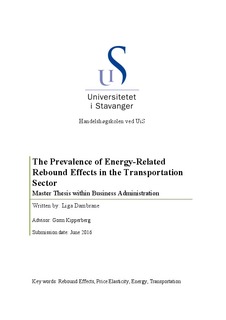| dc.description.abstract | Due to society’s increased involvement for the environment, topics that concern energy
use and greenhouse gas emissions have evolved substantially over the past few years.
The rebound effect is a matter that measures if technological innovation or
implemented government policies lead to the expected decrease in energy use (thereby
decreased emissions), or if the environment is actually worse off after the
implementations. The rebound effects are theoretically classified as a consumer or
producer issue, but it also can be divided into a direct or indirect matter.
This thesis is investigating the direct rebound effects in The Norwegian Transportation
Sector on the consumer side and it also describes the underlying factors that affect
travel demand. In addition, it establishes the present situation of electrical vehicle
evolvement for the Norwegian population. Electrical vehicle policies by the
Norwegian government are indeed incentivized implementations that are supposed to
decrease the green house gas emissions. The implemented government policies might
however be working against its own purposes on the rebound effect framework.
The data analysis is based on data provided by the Institute of Transport Economics, as
well as Statistics Norway and the Information Council for road traffic. The model used
in the data analysis is build on the framework compiled by Sarah West (2004) in form
of a derived indirect utility function. Some adjustments are however made due to data
availability.
The key findings of the thesis are that the Norwegian population is more elastic than
other research usually concludes with, and the rebound effects lie in between 40
percent and up to 441 percent, indicating a very elastic population and the presence of
a partial rebound or even backfire in some models. These results differ from other
research papers about rebound effects, as it usually lies somewhere around 20 percent
so one should be cautious with the interpretation of these findings. Because the
rebound effect varies between models in such a significant manner, some of the models
in the data analysis are not correct. However, the results indicate that the Norwegian
population is very sensitive to price changes and government policies therefore need to
be considered very carefully. | nb_NO |
